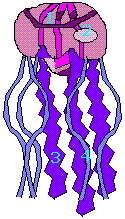Today, I would like to take a look at one of my favorite marine creatures: the jellyfish. Now, you may be wondering, "an article about a fish? Why?" Well, first of all, that question just proved my first point. A jellyfish is not a fish, a common misconception (more on that later). Below are a couple more reasons why I would like to talk about marine creatures like jellyfish:
1. Not everything on the Internet can be trusted. Everyday, many people use information for homework or essays that are wrong. This not only gives you false information for your schoolwork, but for yourself as well. If you learn off of incorrect websites, you're not learning anything!
2. I enjoy marine biology very much, and I hope to share my knowledge with other Whyvillians. Maybe you can even learn something!
Now that we have all of the basic reasons and questions out of the way, it's on to the main event: jellyfish! A common misconception about jellyfish is that many assume to classify them as fish. This is wrong for one simple reason: fish are vertebrates. Being a vertebrate means that a creature, or human like you or me has a spine. Jellyfish do not have a spine; therefore they are classified as an invertebrate. Below, you can find a picture of a common jellyfish I drew myself. You will see numbers on the drawing. For each number, there is a corresponding description of that structure.

1. This is what's called a Bell. The Bell is basically the jellyfish's body. Inside the Bell, there is a mouth, and several sensory nerves that are lined up along the edges of the Bell. The mouth how the jellyfish takes in nutrients. It is the only way out or in of a jellyfish, there is no other way. The sensory nerves allow the jellyfish to smell and to not tilt over and stay upright and stiff (stated earlier: jellyfish are invertebrates, they have no spine, so they need some way to stay upright). These nerves also let the jellyfish detect light shining around them.
2. This is the Stomach Pouch. This small pouch lets the Jellyfish maintain nutrients and "digest" them, taking in all the nutrients.
3. Next, we have the Oral Arms. These protect the Jellyfish from attackers, because they contain nematocysts that sting anything they touch upon impact.
4. These are the tentacles. These are also covered with nematocysts that will sting things upon impact. However, they are also vital to the jellyfish, because they help to gather food.
Well, I'm short on time so hopefully this dive into the world on jellyfish was helpful! Maybe I will able to make more articles pertaining to the unusual creatures of the marine world. I'm Amph, and I'm outta here!
Author's Note: Sources Used: http://www.enchantedlearning.com/subjects/invertebrates/jellyfish/Jellyfishcoloring.shtml (Enchanted Learning, Jellyfish)
http://www.dnr.sc.gov/marine/pub/seascience/jellyfi.html (Sea Science, Jellyfish)